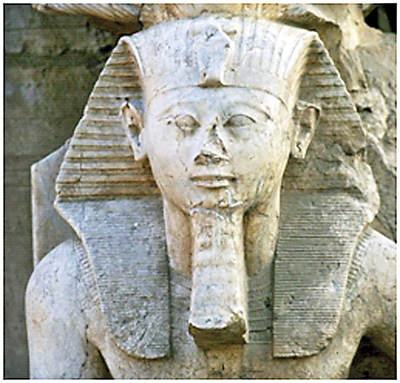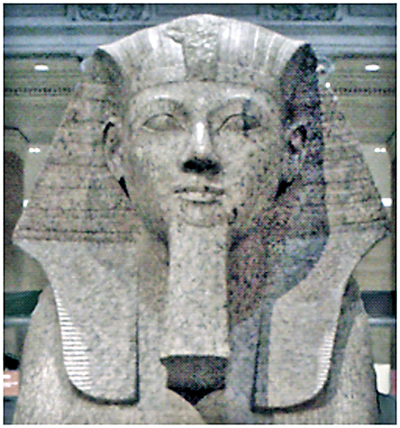Tracing the Pharaoh of Exodus through history

Pharaoh Thutmoses III (1485-1431 BC)
Christian Easter is a syncretic development of the Jewish Passover (Pesach in Hebrew). It celebrates the liberation of Israelites from the slavery of pharaohs in Egypt to freedom in the ‘Promised Land’ as given in the book of Exodus of the Bible. After the ten plagues that Moses brought down on Egypt by the power of God, the Pharaoh let the Hebrews (Israelites) depart from Egypt.
For Christians, Jesus symbolises the lamb that was slain during a Jewish Passover. Christians believe that human suffering has meaning in the suffering, death and resurrection of Jesus, as they recognize their human limitations before God as they strive forward, and in the hope of their resurrection following that of Jesus. For Christians, Easter celebrates the liberation from the darkness of death in evil and sin to light in new life in righteousness and sanctity.
This human aspiration of liberation is deep in human nature, as it manifests itself as an urge in our subconscious. It is manifested as the passing from ignorance to enlightenment, attaining unity of Atman with Brahman and from darkness of death to light in Christ with new life. The latter is symbolised in the Christian paschal candle lit at the Easter liturgy.
The readings at the Easter liturgy also reflect the Passover from death to life in the resurrection of Jesus and in the crossing of the Red Sea from the bondage of Pharaoh. However, Exodus does not name the Pharaoh and Egyptian records do not depict any Exodus in their hieroglyphics. Since critics question the Exodus, it is necessary to search Hebrew and Egyptian sources and archaeology, to cross-check the historicity of Exodus.
According to the Cecil B. DeMille’s film The Ten Commandments(1956), the Pharaoh is Rameses II (1279-1213 BC) of 19th dynasty and Exodus occurred circa 1270 BC. Scripture scholars of the 19th century considered Ramesses II as the Pharaoh of Exodus, because Ex.1:11 states, “…and they built for Pharaoh store-cities, Pithom and Rameses” and Ex. 12:37 states, “And the people of Israel journeyed from Rameses to Succoth, about 600,000 men on foot…”and Num. 33:3 states, “They set out from Rameses in the first month, on the 15 day of the first month…”The error in associating Ramesses II as the Pharaoh of Exodus becomes evident in Gen. 47:11, as it states, “Joseph lived in the land of Rameses…” a land named after Ramesses, when Ramesses was born about 500 years after Joseph. The reason for this is that the author of Exodus got the place correct (former Avaris) but gave the renamed city as Rameses City. Ramesses II built many cities and gave new names, including his own name.

Sarcophagus in the Burial Chamber of Thutmoses III in the Valley of Kings
According to K.A. Kitchen’s dating, Thutmoses III (1464-1431 BC) of the 18th dynasty was the Pharaoh of Exodus, and the exodus occurred in 1446. However, according to the dating of W. Shea, Amenhotep II (1450-1425), the son of Thutmoses III was the Pharaoh of Exodus in 1446.
Biblical sources
There are two biblical events with reliable dates, from which the year of Exodus can be determined. They are (1) the construction of Solomon’s Temple (Jerusalem Temple) and the (2) fall of Jericho. King Solomon began his reign in 970 BC and built the temple in the 4th year of his reign, 480 after the Exodus (1 Kings 6:1). That works out to be 1446 BC (i.e. (970-4) + 480 =1446).
Visitors to Jericho would see the extent of archaeological excavations at the Wall of Jericho. Archaeologists have dated the pottery from Jericho to be 1406 BC. The Bible refers to the 40 year period from the departure from Egypt to entering Jericho by Joshua, (Ex. 16:35; Num.32:13; Deut. 29:5), which also accounts to year 1446 BC (i.e. 1406 + 40 = 1446).
Egyptian sources
Egyptian chronology was related to the “heliacal rising” of Sothis (Dog Star). Depending on whether the sighting of Sothis was from Memphis, Thebes (Luxor) or Elephantine in the records, the ruling Pharaoh at the sighting can be determined. A rising of Sothis was recorded in year 9 of Amenhotep I in the Papyrus Ebers from Thebes. This leads to the conclusion that Amenhotep I was the Pharaoh in 1525 BC.
Hebrews in Egypt and
Pharaoh of Exodus
Jacob (renamed Israel) and his 12 sons (ancestors of ‘Tribes of Israel’) lived in Israel. Joseph was the penultimate son, and his brothers were jealous of his dream interpreting skills. While in the fields, they sold him as a slave to a caravan heading for Egypt. While in an Egyptian prison Joseph interpreted the Pharaoh’s dreams, and he was made a viceroy, circa 1886 BC and entrusted the task of preparing for the upcoming famine. When the famine hit Israel, Joseph’s brothers came to Egypt, and Joseph got his father and brothers to settle in Egypt (Gen. ch. 37-50).

Queen Pharaoh Hatshepsut co-ruled Egypt for 21 years with Thutmoses III
Hyksos kings took over the northern Egypt in 1657 BC and ruled for 100 years. Pharaoh Ahmoses defeated the Hyksos king Khamudi at Goshen in 1557 BC. He was followed by Amenhotep I (1532-1511 BC), who ordered the killing of male children born to Hebrew parents, and Thutmoses I (1511-1498 BC) continued that policy.
Moses was born to Hebrew parents, but his mother placed him in a basket and left him on the edge of Nile where Hatshepsut, the daughter of Pharaoh Thutmoses I and Queen Almoses came to bathe. She saw the baby and adopted him as her son. Hatshepsut married her step-brother Thutmoses II (1498-1485 BC), and he too continued to oppress the Hebrews (Ex.2:11). When Moses was 40, he saw a Hebrew being tortured by an Egyptian, whom he killed and escaped to Median in Saudi Arabia. Thutmoses II had a son, Thutmoses III by another queen, Islet. When Thutmoses II died, Hatshepsut began to co-rule Egypt with her infant step-son Thutmoses III for 21 years.
Hatshepsut was the only female pharaoh, and she wore an artificial beard. When Hatshepsut died in 1465 BC at the age of 77, Thutmoses III became the ruler and continued to oppress the Hebrews. Moses returned to Egypt from Median and demanded that the Hebrews be freed and allowed to return to their homeland. At first, the Pharaoh refused to let them go, but when the 10th plague killed the 1st born in Egypt, includingthe Pharaoh’s son, he let the Hebrews go. Hence, Thutmoses III is considered the Pharaoh of Exodus, and Exodus occurred in 1446 BC. After the Exodus, he ruled for another 15 years till 1431 BC. As Moses was leaving Egypt, the Pharaoh changed his mind and sent his army to recapture the Hebrews. The sea parted to let the Hebrews cross but when Pharaoh’s army pursued them, the waters closed and drowned them.
The 17 military campaigns of Thutmoses III that occurred one per year abruptly ended after 1446 BC, after his army was drowned in the Red Sea. Perhaps his previous military campaigns over Canaann, as given in his Victor Stele, helped Joshua to conquer that country easily, as it may have been weakened by Egyptian wars. When Hatshepsut died, Thutmoses III defaced the figures of Hatshepsut for bringing Moses into the family and another male figure (possibly Moses or Senmut) in the Temple of Hatshepsut, as clearly visible today. Thutmoses III (1485-1431 BC) was followed by his second son, Amenhotep II (1431 – 1406 BC) as the 1st born was killed in the 10th plague.
Two other interesting pharaohs of the 18th Dynasty are Akhenaten (1358-1341 BC) and his son Tutankhamun (1341-1331 BC).Amarna Tablet dating back to the 14th century BC from the city of Akhenaten states, “The land of the King is lost to the Habiru, and now indeed a city of the territory of Jerusalem,” a reference to the conquest of Canaan by Joshua.
Joshua died in 1336 BC, two years after Akhenaten came into power. Akhenaten believed in the God of Hebrews, as he saw the timid nation of Hebrew slaves changing to conquerors, because of their trust in one God. He then introduced monotheism to Egypt, though believing in Ra the sun god. In his Moses and Monotheism published by Sigmund Freud in 1939, Freud erroneously says that Moses copied monotheism from Egypt, when in reality Akhenaten copied monotheism from Moses. Freud had considered the Pharaoh of Exodus to be Rameses II and got the dates wrong. Multiple-lines of evidence from the Bible, archaeology and Egyptian history indicate that Thutmoses III was the Pharaoh of Exodus, and Exodus could have occurred in 1446 BC.
The tomb of Thutmoses III is in the Valley of Kings and his mummy is in the Cairo Museum.


